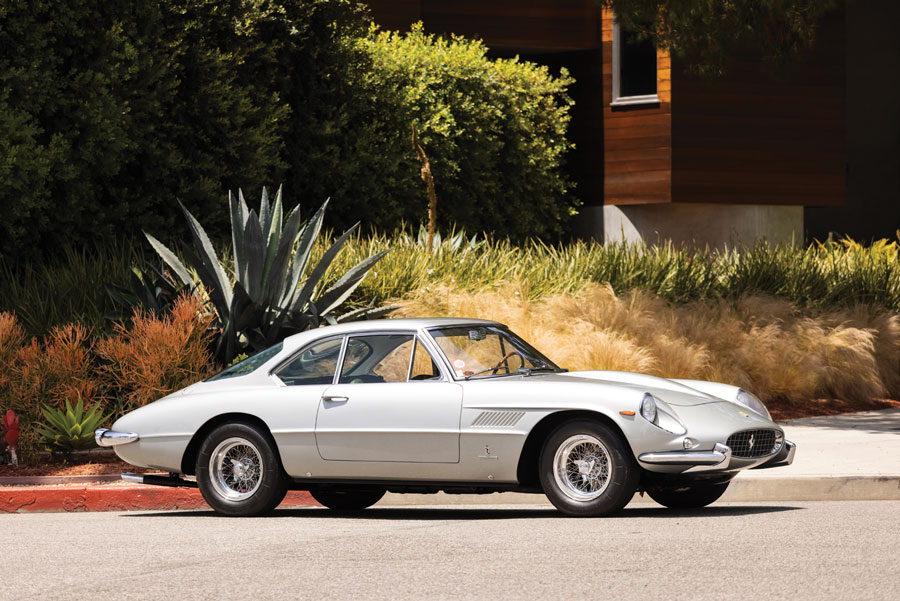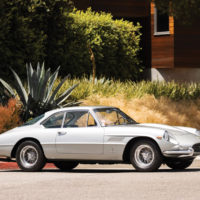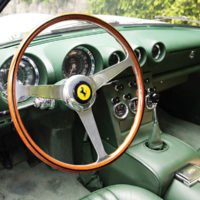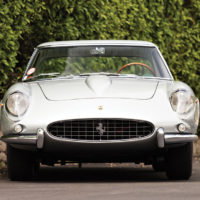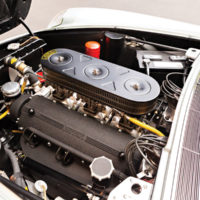SCM Analysis
Detailing
| Vehicle: | 1963 Ferrari 400 Superamerica Series II Aerodinamico Coupe |
| Years Produced: | 1959–64 |
| Number Produced: | 47 |
| SCM Valuation: | $3,080,000 |
| Tune Up Cost: | $3,000 |
| Chassis Number Location: | Left frame member by the steering box |
| Engine Number Location: | Right rear above the motor mount |
| Club Info: | Ferrari Club of America |
| Website: | http://www.ferrariclubofamerica.org |
| Alternatives: | 1959–63 Aston Martin DB4GT, 1952–55 Bentley R-type Continental, 1959–64 Maserati 5000 GT |
| Investment Grade: | A |
This car, Lot 45, sold for $2,535,000, including buyer’s premium, at Gooding & Company’s Pebble Beach Auctions, on August 13, 2021.
Luigi Chinetti was just 16 years old when he went to work as a mechanic for Alfa Romeo. It was there that he met Enzo Ferrari, and their paths would be forever crossed. Uncomfortable with the rise of Benito Mussolini and his National Fascist Party, Chinetti would move to Paris prior to World War II. As the war broke out, he relocated to the United States.
A talented mechanic with a racing background, Chinetti easily found work in the American motorsports scene. There he would develop important relationships with influential racing personalities such as Zora Arkus-Duntov, who would later sponsor Chinetti’s U.S. citizenship.
Chinetti returned to Paris after the war, only to find his assets had been destroyed, so he continued south to his native country. In a fateful meeting on Christmas Eve in 1949, Chinetti convinced Enzo Ferrari of the U.S. market’s potential and became Ferrari’s U.S. agent. Chinetti’s predictions proved prophetic, and America quickly became so important to the company that Ferrari produced a model named for it.
American history
The 340 America was the first of a small series of premium Ferraris that would pay homage to the U.S. They would also be some of the most special and exclusive models the company would ever produce. The first 340 America was built in 1950, the third year of Ferrari production. The chassis number, 0082, indicates it was one of the first 100 Ferraris built and given the even chassis number of a competition model.
What made the 340 America special was its powerful engine, a trait that would continue with subsequent “America” models. Early Ferrari Formula One cars used small-displacement engines designed by Gioacchino Colombo. Those engines used superchargers to produce power equivalent to the larger-displacement engines of some competitors. In 1949, Ferrari enlisted Aurelio Lampredi to design a large-displacement racing engine.
Lampredi’s design featured cylinder liners that screwed into the block instead of being pressed in. This required wide spacing between the bore centers, and the Lampredi engines are known as long-blocks for their unusually large size. The large displacement produced large power, and the brutes were immediately successful on the racetrack.
In general terms, the GT models preceding the 340 America featured 1.5- to 2.3-liter Colombo engines. The 340 America became the first GT model to feature a Lampredi engine, in this case, a 4.0-liter behemoth with enough torque to scare the most seasoned pilot.
The 340 America would be followed by a similar 342 America in 1952 and then the 375 America in 1954. The 375 America was based on a 250 Europa, a semi-production model, powered by a 3-liter V12. The 375 was upgraded to a 300-horsepower 4.5-liter Lampredi engine. The 375 America carried an odd chassis number, noting the America’s evolution to a premium GT model.
Just 22 Americas had been built when Ferrari introduced the 410 Superamerica in 1956. As the name indicates, the Superamerica was a major upgrade of the previous models. The 410 was powered by an impressive 340-hp, 5-liter Lampredi engine, and the “Super” was found in the styling. Ferrari charged Pinin Farina with giving the Superamerica a show-car look, and the client the ability to tailor the car to their personal specifications. This was a bespoke model that would only be available to Ferrari’s most important clients. Just 34 would be produced, and these Pinin Farina-built cars are often considered the highest-quality Ferraris ever produced.
The Superamerica evolves
That brings us to the 400 Superamerica. The Lampredi engines were complicated and expensive, so, for the 400, Ferrari produced a 4-liter version of its tried-and-true Colombo engine. The new engine claimed the same 340 horsepower as the 410 Lampredi but was less complex.
Building on the bespoke nature of the series, the 400 Superamerica was available in a variety of body styles, including several one-offs. Depending on the source, 46 or 47 400 Superamericas were built, with 36 coupes and 11 cabriolets the popular total. The early cars were built on a 2,400-millimeter Series I chassis. The later Series II chassis was extended to 2,600 millimeters to accommodate a more-spacious interior.
Our subject car, 400 Superamerica 4251SA, features a Series II LWB chassis and the model-defining covered-headlight, Aerodinamico coupe body. The shape was based on a Pinin Farina study on aerodynamic design. The shape proved ineffective in a racing environment but made a dramatic GT car. The design looks straight from an auto-show display. In fact, 4251SA was still awe-inspiring when it was shown at the 1963 New York Auto Show, four years after the model’s introduction.
All 400 Superamericas were odd-numbered, indicating they were intended to be GT models, but that doesn’t mean they didn’t see the track. One famous example was a 400 bodied like a 250 GTO; competitors were tricked into assuming the 4-liter car was a standard 3-liter GTO. In another example, a modified 400 engine placed in a Testa Rossa chassis won the 1962 24 Hours of Le Mans.
Following 4251SA’s show debut, it stayed in the U.S. with a couple of longtime owners. It has been shown in the U.S. and Europe, picking up several prestigious awards. The car is in exceptional condition with no known black marks in its history.
Exclusive and expensive
Gooding & Co. estimated 4251SA at $2,000,000–$2,600,000. The hammer fell at an all-in total of $2,535,000. Various price guides valued the car higher (and so would I). We can attribute the difference to averaging in the sales of rarer and one-off models.
The seller had another big Ferrari on auction at Monterey and he had a third Ferrari on Pebble’s Sunday field. I trust he knew what his car was worth and got the right number.
It’s difficult to understate the luxury, performance and exclusivity of the “America” Ferraris. They could cost as much as two Rolls-Royces and were only available from specially authorized Ferrari dealers. The buyer joined an exclusive club of coachbuilt-Ferrari owners. Every time they look at their car, they will discover a new and fascinating detail, never regretting the purchase. ♦
(Introductory description courtesy of Gooding & Co.)
